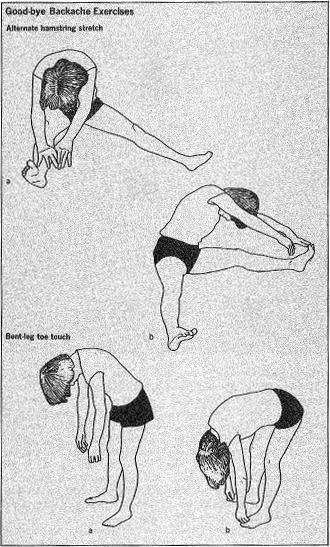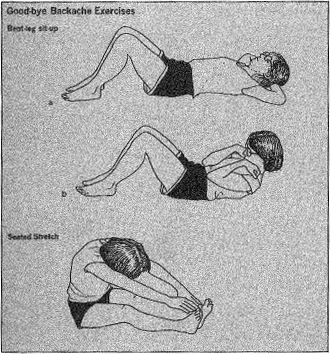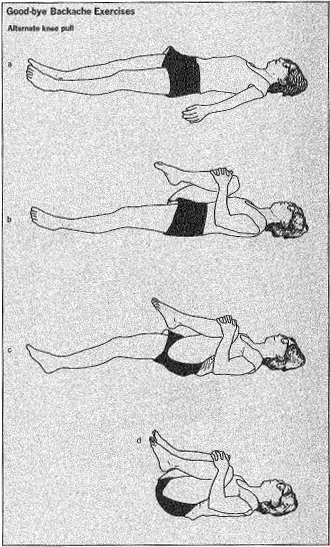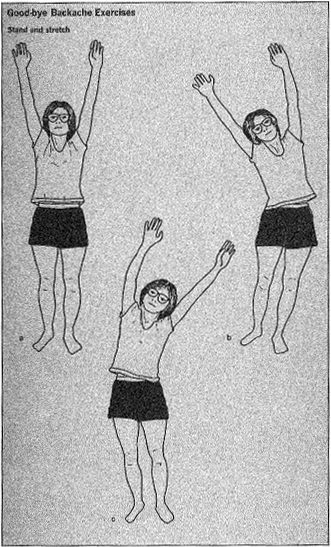Starting With Some Easy Exercises - Low-back pain
Health authorities have estimated that nearly one in every six Americans suffers from low-back pain. Drugs and medications for the relief of such pain earn their manufacturers millions of dollars a year. But low-back pains may often be most effectively attacked with carefully planned and regularly pursued exercise routines.
The causes of low-back pains can vary. Tension can be to blame. A similar result occurs when the lower vertebrae have been compressed or crowded together. In other instances body positions of movements cause direct muscle or ligament strain.
Where such body mechanics have led to low-back pain, the fault usually lies with posture. If the pelvis slants downward, the lower back develops an abnormal curve and presses on the nerves of the spinal column. The pressure becomes so severe sometimes that the disks of cartilage that protect the nerves cannot do their job.
Muscle Weakness and Tension
Some medical authorities hold that vertebral compression produces only about one-fifth of all the cases of low-back pain that afflict Americans. The other 80 per cent result from simple weakness of the muscles of the back, the abdomen, the hips (the psoas group), the hip extensors (gluteals), and the hamstrings.
Tension also plays a major role. The muscle groups that support and control the movements of the torso tighten up, often because they lack strength and flexibility. And lack of strength and flexibility results from inadequate exercise.
Relief of Low-Back Syndrome
Is it any wonder that medications that promise to reduce low-back pain sell so well? The search for relief from such pain may occupy many of the waking hours of the sufferer—and cost a substantial amount of money. Yet the best way to relieve low-back syndrome is to avoid it. That means the individual must keep the important muscles involved in trunk support and movement strong and flexible. Such flexibility, once achieved, not only reduces the chances of low-back pain, but also provides the body with greater agility and mobility.
If low-back syndrome cannot be avoided in the first place, it can be relieved through exercise. Physical activities, sports, and games of nearly all kinds that involve movement of the body help eliminate muscle tension. The activities also provide a safe outlet for nervousness and tension which can, as noted, make their own contribution to low-back syndrome.
The Exercises
Many movements, exercises, and activities that help the fitness beginner to rid himself of low-back pain can be included in a fitness program. They should generally be performed on a firm, flat surface. They require repetition, but the number of repetitions can often be a judgment matter. Each person should gauge his tolerance for such exercises by the ways in which his or her body reacts to them.
The exercises described below are particularly adapted to alleviating the specific conditions for which they are prescribed. But many others to be mentioned later will also help to improve these conditions, if less directly, while also serving one or more of the five basic fitness goals.


Like those in the preceding set, these exercises should be performed slowly and carefully. The subject should begin by lying on his back with his arras at his sides, palms facing down. The knees should be flexed, either by resting them on a pillow or by placing the feet flat on the ground. Breathe slowly and deeply at least five times, inhaling through the nose and exhaling through the mouth. Thus relaxed, you are ready to proceed with these exercises:
1. Contract your abdominal and gluteal muscles at the same time so as to bring your back flat against the floor. After holding that position for six seconds, relax. Repeat the process ten to 20 times. You can perform the same movements with your legs straight. You may want to try contracting the abdominals and gluteals from time to time during the day as a means of strengthening these muscles.
2. To stretch your back, starting from the same position and with your back flat against the floor as above, raise your head. At the same time bring both knees up as far as your chest while clasping your hands around your knees. Exert pulling pressure with your hands for six seconds, then relax and resume your original position. Repeat 10 to 20 times.


3. To strengthen the muscles of the hip joint start in the same position, with your arms at your sides. Your knees should be relaxed, your legs stretched out. Simultaneously contract your stomach muscles and flatten your back. Raising your head, bring one knee up to your chest. The other knee should remain relaxed. Repeat 10 to 20 times, alternating legs.
4. Beginning on your hands and knees and keeping your head, neck, and back straight, raise one knee up and back as far as possible. Keep your upraised leg flexed and your back straight. Return to your starting position on hands and knees and repeat 10 to 20 times, alternating legs.
5. Stand with your feet together and your hands at your sides. To strengthen your low-back muscles and at the same time stretch your hamstrings, bend over slowly from the hips. Bring your arms back as far as possible. Return slowly to the starting position. Repeat 10 to 20 times.
Supplementary Back-pain Relievers
Two other exercises help relieve the low-back pains that make life miserable for so many persons. Both exercises contribute to flexibility; both are simple and easy to master.
1. In the head pull-back , drop your head until your chin touches your chest. Clasp your hands behind your head. Moving your head upward slowly and then backward as far as possible, keep pressure on the back of your head with your hands. In this isometric movement your head should go back as far as you can move it. Once back, count slowly to five while maintaining the hand pressure. Relax and repeat half a dozen times. Rest for about five seconds between repetitions.
2. In the monkey slump , stand with your feet spread apart and your knees slightly bent. With your hands on your knees, and while breathing in deeply, tense all your body muscles to a moderate degree. Then exhale slowly and let your hands slip from your knees. Your body should slump forward until your hands touch—or almost touch— the floor. Your chin should be level with your thighs. Maintain the slump for three to five seconds. Repeat half a dozen times.

Comment about this article, ask questions, or add new information about this topic: